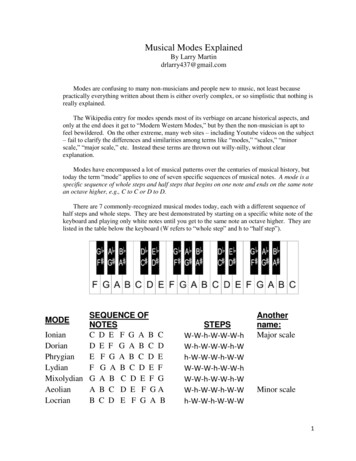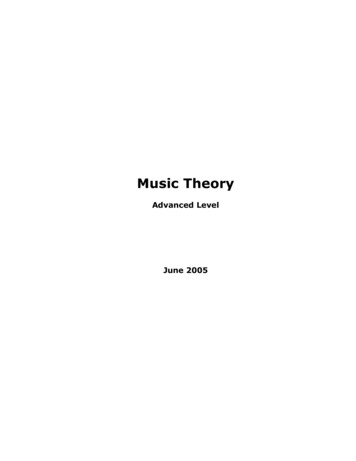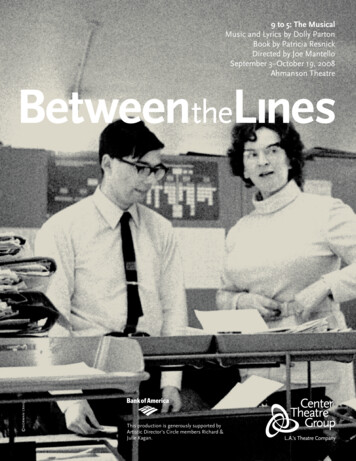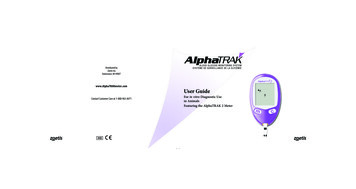
Transcription
Musical Modes ExplainedBy Larry Martindrlarry437@gmail.comModes are confusing to many non-musicians and people new to music, not least becausepractically everything written about them is either overly complex, or so simplistic that nothing isreally explained.The Wikipedia entry for modes spends most of its verbiage on arcane historical aspects, andonly at the end does it get to “Modern Western Modes,” but by then the non-musician is apt tofeel bewildered. On the other extreme, many web sites – including Youtube videos on the subject– fail to clarify the differences and similarities among terms like “modes,” “scales,” “minorscale,” “major scale,” etc. Instead these terms are thrown out willy-nilly, without clearexplanation.Modes have encompassed a lot of musical patterns over the centuries of musical history, buttoday the term “mode” applies to one of seven specific sequences of musical notes. A mode is aspecific sequence of whole steps and half steps that begins on one note and ends on the same notean octave higher, e.g., C to C or D to D.There are 7 commonly-recognized musical modes today, each with a different sequence ofhalf steps and whole steps. They are best demonstrated by starting on a specific white note of thekeyboard and playing only white notes until you get to the same note an octave higher. They arelisted in the table below the keyboard (W refers to “whole step” and h to “half step”).SEQUENCE OFNOTESIonianC D E F G A B CDorianD E F G A B C DPhrygianE F G A B C D ELydianF G A B C D E FMixolydian G A B C D E F GAeolianA B C D E F GALocrianB C D E F G A WAnothername:Major scaleMinor scale1
Any two adjacent keys – black or white – are a half step apart. For example, C-C# are a halfstep apart, as are E-F and B-C. Any two keys with one key in between them are a whole stepapart. For example, C-D are a whole step apart, as are E-F# and B-C#. What you really havewith each new mode is a different sequence of half steps and whole steps, and it is that specificsequence that defines each mode.Historically, the term “mode” and not “scale” was used for all these note sequences, goingback to the ancient Greeks. Over time, the term for two particular modes – ionian and aeolian –came to be called “scales.” Today we call the ionian mode the major scale, and the aeolian modethe minor scale (more specifically, the natural minor scale). The term “mode” is still used for theother note sequences. This variation in terminology is one reason for confusion generated bymany articles and web videos about modes. Although all 7 modes are variations on whole-stephalf-step sequences, only two of the variations are now called “scales” and the other five are stillcalled “modes.”So both “mode” and “scale” are simply a sequence of 8 notes, with the intervals between twosuccessive notes either a half step or whole step apart. Whole step and half step are bestappreciated on the piano keyboard, shown above. (Each black key can be labeled as a sharp or aflat.)The seven modes, with their sequence of whole steps and half steps, are shown in anothertable, below. Note that the ionian mode is also the major scale, and the aeolian mode is the minorscale. (More specifically, the aeolian mode is the natural minor scale. There are two other minorscales, the harmonic minor and melodic minor, which are not represented by any of these modes.)Major scaleMinor ScalescaleThis table emphasizes the point that each mode can be determined by starting on a successivenote of the C major scale (white keys only). In this way all the half steps are B-C and E-F.Again, the term “minor scale” in this table is the natural minor scale. (Table is fromhttp://www.lotusmusic.com/lm modes.html.) If you start on C and play C-D-E-F-G-A-B-C you will get the C ionian modesequence, which is W-W-h-W-W-W-h. This is also the sequence for themajor scale. The ionian mode and the major scale are synonymous.If you start on D and play D-E-F-G-A-B-C-D you will get the D dorian modesequence, which is W-h-W-W-W-h-W. This mode does not have another2
scale name. It goes by the name of the root note and “dorian.” Thus if youstart the scale on D it is “D dorian”; if you start on E it is “E dorian,” etc.If you start on E and play E-F-G-A-B-C-D-E you will get the E phrygianMode sequence, which is h-W-W-W-h-W-W. This mode does not haveanother scale name. It goes by the name of the root note and “phrygian.”Thus if you start the scale on E it is “E phrygian”; if you start on F it is “Fphrygian,” etc.If you start on A and play A-B-C-D-E-F-G-A you will get the aeolian modesequence, which is W-h-W-W-h-W-W. This is also the sequence for thenatural minor scale. The aeolian mode and natural minor scale aresynonymous.Similarly, the other four modes have a unique sequence of half steps and wholesteps.***So that’s how the modes are derived and named. Once you understand that eachmode has a specific pattern of whole steps and half steps, it should be easy to see thatwithin each mode there are 12 possible scales or “keys”. That’s because, within anyoctave there are 12 possible notes. The full octave that includes all the keys is called thechromatic scale, and is best visualized on the piano keyboard. From C to C are 12 notes(not counting the 2nd C).Chromatic ScaleTo create the 12 possible scales for any given mode, all you do is take that mode’sspecific sequence of whole steps and half steps and start it on each of the 12 chromaticscale keys. For example, by moving the ionian pattern so that it starts on D, you nowhave the D ionian mode (D major scale). In order to keep the same pattern of whole stepsand half steps, this D major scale includes both F# and C#.D – E – F# – G – A – B – C# – DWWhWWWhSo there are 12 possible major scales, or keys, for the ionian mode. These majorscales are listed below, with four examples shown on the treble clef. They all have theionian (major scale) sequence of whole notes and half notes: W-W-h-W-W-W-h.Note the terminology in the treble clef examples. The C major ionian mode is calledsimply “ionian mode.” The D major scale is called “D ionian”. The E major scale is3
called “E ionian.” The F major scale is called “F ionian.” By convention, we now usethe major scale names for these ionian modes: C major, D major, E major and F major.Ionian modes Major scalesFour Ionian Modes on the Treble ClefW-W-h-W-W-W-hC majorDb majorD majorEb majorE majorFb majorF majorGb majorG majorAb majorA majorB majorC majorD majorE majorF major4
There are also 12 possible natural minor scales, or keys, which is identical to saying thereare 12 possible aeolian modes. These natural minor scales are listed below, with fourexamples shown on the treble clef. They all have the aeolian (minor scale) sequence ofwhole notes and half notes: W-h-W-W-h-W-W.Aeolian modes Natural minor scalesW-h-W-W-h-W-WC minorDb minorD minorEb minorE minorFb minorF minorGb minorG minorAb minorA minorB minorFour Aeolian Modes on the Treble ClefA minorC minorD minorE minor5
You can do this exercise for the other five modes as well. Each mode has 12 possible keys,because there are 12 keys of the chromatic scale. Below are listed all the keys for the other fivemodes, starting on C of the chromatic scale. Also shown is the key of C for that mode on thetreble clef.Chromatic ScaleDorian modesSequence: W-h-W-W-W-h-WC# DorianD DorianD# DorianE DorianF DorianF# DorianG DorianG# DorianA DorianA# DorianB DorianPhrygian modesSequence: h-W-W-W-h-W-WC PhrygianC# PhrygianD PhrygianD# PhrygianE PhrygianF PhrygianF# PhrygianG PhrygianG# PhrygianA PhrygianA# PhrygianB PhrygianLydian modesSequence: W-W-W-h-W-W-hC LydianC# LydianD LydianD# LydianE LydianF LydianF# LydianG LydianG# LydianA LydianA# LydianB Lydian6
Mixolydian modesSequence: W-W-h-W-W-h-WC MixolydianC# MixolydianD MixolydianD# MixolydianE MixolydianF MixolydianF# MixolydianG MixolydianG# MixolydianA MixolydianA# MixolydianB MixolydianLocrian modesSequence: h-W-W-h-W-W-WC LocrianC# LocrianD LocrianD# LocrianE LocrianF LocrianF# LocrianG LocrianG# LocrianA LocrianA# LocrianB LocrianAgain, note the difference in nomenclature between ionian/aeolian modes and the other modes. Ionianmodes are called by the names of the major scale, e.g., C major, D major, etc.; they are not called Cionian, D ionian, etc. Aeolian modes are called by names of the minor scale, e.g., C minor, D minor, etc.,and not C aeolian or D aeolian. The other modes are called by their modal name.7
Music in the Various ModesWhile most music played today is in either ionian or aeolian mode (or the other minor scales, harmonicand melodic), there are many pieces of music in the other modes. Below are some examples of music ineach of the modes. The majority of popular music is written in one of the major scales (i.e., ionianmode), but there is also much music in the minor scale. Classical music often combines major and minorscales. One interesting category included below is music written in all 24 major and minor keys (i.e., the12 major scales and the 12 minor scales).Musical composition is very complex, and classical music as well as popular songs may use more thanone mode. This list is simply to show examples gleaned from the internet. Web site sources specific to amode are listed under the mode. Web sites that cover more than one mode w.dreamtheaterforums.org/boards/index.php?topic eolian-mode-minor-key-whats-thedifference/Major scale (ionian mode)“Happy Birthday”“God Bless America”“Star Spangled Banner”“Yankee Doodle”“You Are My Sunshine”Mozart symphony #23 in D majorBeethoven Symphony #1 in C majorBeethoven Symphony # 7 in A majorSchubert Symphony #9 in C majorMinor scale(The aeolian mode is the natural minor scale; much minor scale music is also in harmonic or melodicminor scales, which are variations of the natural minor and technically not the aeolian mode)ClassicalBeethoven Symphony #5 in C minorMozart symphony #40 in G minorBrahms Symphony #1 in C minorBrahms Symphony #4 in E minorTchaikovsky Symphony #1 in G minorPopular: gs-in-a-minor/Bob Dylan - All Along the WatchtowerR.E.M. - Losing My Religion (R.E.M.)Animals – House Of The Rising Sun (Animals version)Bob Dylan – HurricaneThe Beatles – Things we said todayThe Beatles – Glass OnionThe Beatles – Happiness is a warm gun8
The Beatles – While My Guitar Gently WeepsThe Beatles – I Me MineThe Beatles – I Want You (She’s So Heavy) (Verses in A minor, Instrumental part in D minor)John Lennon – Working Class HeroMusic written in all 24 major and minor keyshttps://en.wikipedia.org/wiki/Music written in all major and/or minor keys Johann Sebastian Bach: The Well-Tempered Clavier (1722 and 1742; two separate sets of 24Preludes and Fugues, together known as "the 48") Frédéric Chopin: 24 Preludes, Op. 28 (1835–39) Charles-Valentin Alkan: 25 Preludes, Op. 31 (1847), 24 Études in all the major and minor keys,Opp. 35 and 39 (1848 and 1857) Alexander Scriabin: 24 Preludes, Op. 11 (1893–95) Sergei Rachmaninoff: 24 Preludes, Opp. 3/2, 23 and 32 (1892; 1901–03; and 1910) Paul Hindemith: Ludus Tonalis (1942, twelve keys) Dmitri Shostakovich: 24 Preludes and Fugues, Op. 87 (1950–51). He also wrote a separate set of24 Preludes, Op. 34, in 1933Dorian modehttps://en.wikipedia.org/wiki/Dorian modeSmoke on the Water by Deep PurpleScarborough FairEleanor Rigby (The Beatles)Dear Old Stockholm - (Miles Davis)Bach - Toccata and Fugue in D minor, BWV 538 (NOT the famous one, which is BWV 565)“Drunken Sailor”9
Phrygian modehttps://en.wikipedia.org/wiki/Phrygian modeLiszt’s Hungarian Rhapsody No.2Rimsky Korsakov’s ScheherezadeVaughan Williams’s Fantasia on a Theme of Thomas TallisFinal aria of Philip Glass’s Satyagraha.Samuel Barber’s Adagio for Strings, op. 11Lydian 1l2fsr/any good suggestions for lydian mode pieces/Chopin’s Mazurka No. 15Theme to “The Simpsons”Stravinsky – Prelude in the Lydian ModeThird movement of Beethoven' s String Quartet No. 15 in A minorOs Justi by BrucknerMixolydian modehttps://en.wikipedia.org/wiki/Mixolydian mode“Norwegian Wood” by The Beatles (some verses in Dorian mode)Theme to the TV series Star TrekDebussy’s “The Sunken Cathedral”“The Wreck of the Edmund Fitzgerald” by Gordon Lightfoot“Hey Jude” by the Beatles“Express Yourself” by Madonna“Let it Loose” by The Rolling Stones“Old Joe Clark”10
Locrian modehttps://en.wikipedia.org/wiki/Locrian modeJohn Kirkpatrick's song “Dust to Dust”Brief passages of Sibelius Rachmaninov (Prelude in B minor, op. 32, no. 10), Hindemith (LudusTonalis), and Sibelius (Symphony no. 4 in A minor, op. 63) “may be regarded as in the Locrianmode.”Debussy's Jeux has three extended passages in the Locrian mode.11
Below are some examples of music in each of the modes. The majority of popular music is written in one of the major scales (i.e., ionian mode), but there is also much music in the minor scale. Classical music often combines major and minor scales. One interesting category included below is music










